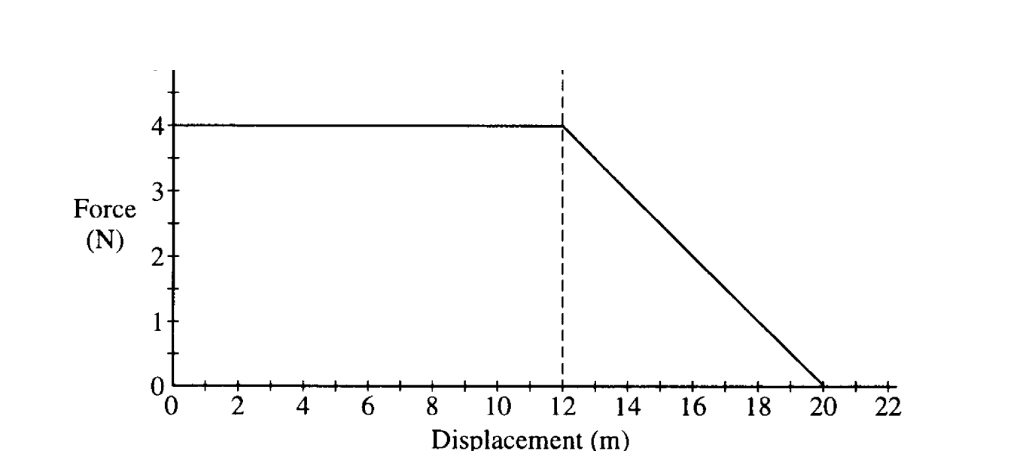Question (12 points, suggested time 25 minutes)
(a) A student of mass MS, standing on a smooth surface, uses a stick to push a disk of mass MD. The student exerts a constant horizontal force of magnitude FH over the time interval from time t = 0 to t = tf while pushing the disk. Assume there is negligible friction between the disk and the surface.
i. Assuming the disk begins at rest, determine an expression for the final speed vD of the disk relative to the surface. Express your answer in terms of FH, tf , MS, MD, and physical constants, as appropriate.
ii. Assume there is negligible friction between the student’s shoes and the surface. After time tf , the student slides with speed vS. Derive an equation for the ratio vD / vS. Express your answer in terms of MS, MD, and physical constants, as appropriate.
(b) Assume that the student’s mass is greater than that of the disk (MS > MD). On the grid below, sketch graphs of the speeds of both the student and the disk as functions of time t between t = 0 and t = 2tf . Assume that neither the disk nor the student collides with anything after t = tf . On the vertical axis, label vD and vS. Label the graphs “S” and “D” for the student and the disk, respectively.
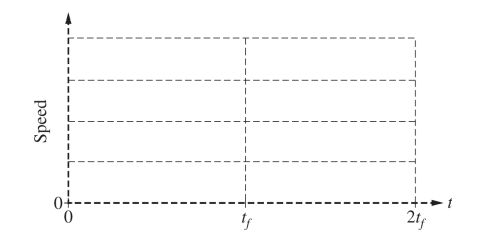
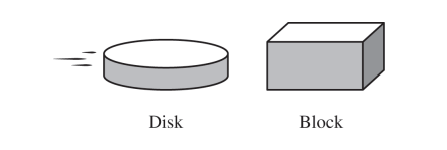
(c) The disk is now moving at a constant speed v1 on the surface toward a block of mass MB, which is at rest on the surface, as shown above. The disk and block collide head-on and stick together, and the center of mass of the disk-block system moves with speed vcm.
i. Suppose the mass of the disk is much greater than the mass of the block. Estimate the velocity of the center of mass of the disk-block system. Explain how you arrived at your prediction without deriving it mathematically.
ii. Suppose the mass of the disk is much less than the mass of the block. Estimate the velocity of the center of mass of the disk-block system. Explain how you arrived at your prediction without
deriving it mathematically.
iii. Now suppose that neither object’s mass is much greater than the other but that they are not necessarily equal. Derive an equation for vcm. Express your answer in terms of v1, MD, MB, and
physical constants, as appropriate.
iv. Consider the scenario from part (c)(i), where the mass of the disk was much greater than the mass of the block. Does your equation for vcm from part (c)(iii) agree with your reasoning from part (c)(i) ?
____ Yes ____ No
Explain your reasoning by addressing why, according to your equation, vcm becomes (or approaches) a certain value when MD is much greater than MB.
▶️Answer/Explanation
Ans:
(a) (i)
\(a = \frac{V_{p}}{T_{f}}\)
FH = MS a
\(F_{H} = (M_{D})\left ( \frac{Vp}{Tf} \right )\)
\(F_{H} T_{F} = (M_{D})V_{P}\)
\(V_{D} = \frac{F_{H}T_{F}}{M_{D}}\)
(ii)
\(\frac{V_{D}M_{P}}{V_{S}M_{S}}\)
(b)
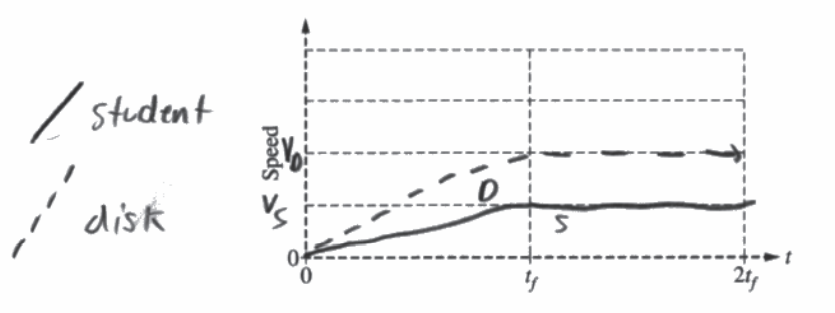
(c) (i)
The velocity of the system will be slightly less than V1 . COP – mv = (m + mb)v. Because the mass of the disk-block system is slightly greater than the disk.
(ii)
The velocity of the disk-block system will be much less than V1. Ove to the law of conservation of momentum a larger mass collision decreases velocity.
(iii)
V1 M0 = Vcm (MD + MB)
Vcm = \(\frac{V_{1}M_{D}}{\left ( M_{D} + M_{B}\right )}\)
(iv)
___X___ Yes _______No
Because Vcm is equal to the ratio of MD to MD + MB multiqlied by V1. In this scenario the ratio of MD / (MD + MB) is slightly less than I which would make V1 slightly less than Vcm
Question: (7 points, suggested time 13 minutes)

Identical blocks 1 and 2 are placed on a horizontal surface at points A and E, respectively, as shown. The surface is frictionless except for the region between points C and D, where the surface is rough. Beginning at time At , block 1 is pushed with a constant horizontal force from point A to point B by a mechanical plunger. Upon reaching point B, block 1 loses contact with the plunger and continues moving to the right along the horizontal surface toward block 2. Block 1 collides with and sticks to block 2 at point E, after which the two-block system continues moving across the surface, eventually passing point F.
(a) On the axes below, sketch the speed of the center of mass of the two-block system as a function of time, from time tA until the blocks pass point F at time tF . The times at which block 1 reaches points A through F are indicated on the time axis.
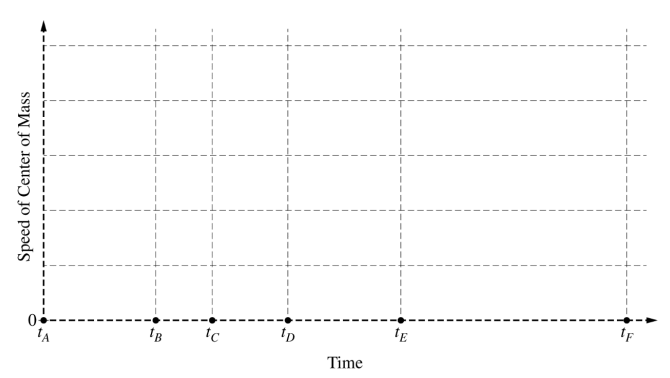

(b) The plunger is returned to its original position, and both blocks are removed. A uniform solid sphere is placed at point A, as shown. The sphere is pushed by the plunger from point A to point B with a constant horizontal force that is directed toward the sphere’s center of mass. The sphere loses contact with the plunger at point B and continues moving across the horizontal surface toward point E. In which interval(s), if any, does the sphere’s angular momentum about its center of mass change? Check all that apply.
____ A to B ____ B to C ____ C to D ____ D to E _____ None
Briefly explain your reasoning.
▶️Answer/Explanation
Ans:
(a)
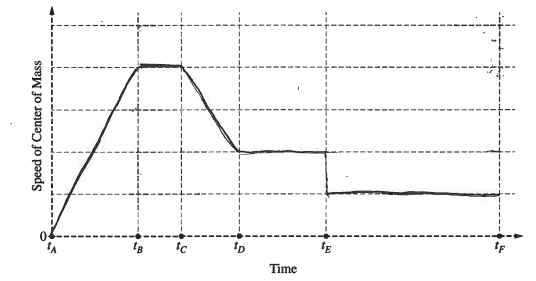
(b)
__√___ C to D
A change in angular momentum means that the sphere has a torque being applied to it over a period of time, (L = tot), a torque is not applied from A to B because the force is directed towards the center of mass, since the surface is frictionless at B to C and D to E, there is no force that is applied to the sphere, and therefore no torque A torque is only applied during the interval from C to D, since the surface is rough, which means that friction exist. The force of friction applied a torque to the sphere causing the angular momentum to change at C to D.
Question
A 0.20 kg object moves along a straight line. The net force acting on the object varies with the object’s displacement as shown in the graph above. The object starts from rest at displacement x = 0 and time t = 0 and is displaced a distance of 20 m. Determine each of the following.
a. The acceleration of the particle when its displacement x is 6 m.
b. The time taken for the object to be displaced the first 12 m.
c. The amount of work done by the net force in displacing the object the first 12 m.
d. The speed of the object at displacement x = 12 m.
e. The final speed of the object at displacement x = 20 m.
f. The change in the momentum of the object as it is displaced from x = 12 m to x = 20 m
▶️Answer/Explanation
Ans:
a) The force is constant, so simple Fnet = ma is sufficient. (4) = (0.2) a a = 20 m/s2
b) Use d = vit + ½ a t2 12 = (0) + ½ (20) t2 t = 1.1 sec
c) W = Fd W = (4 N) (12 m) = 48 J
d) Using work energy theorem W = ∆K (Ki = 0) W = Kf – Ki
W = ½ m vf2
Alternatively, use vf 2 = vi2 + 2 a d 48J = ½ (0.2) (vf2) vf = 21.9 m/s
e) The area under the triangle will give the extra work for the last 8 m
½ (8)(4) = 16J + work for first 12 m (48J) = total work done over 20 m = 64 J
Again using work energy theorem W = ½ m vf2 64 J = ½ (0.2) vf2 vf = 25.3 m/s
Note: if using F = ma and kinematics equations, the acceleration in the last 8 m would need to be found using the average force over that interval.
f) The momentum change can simply be found with ∆p = m∆v = m(vf – vi) = 0.2 (25.3 – 21.9) = 0.68 kg m/s

